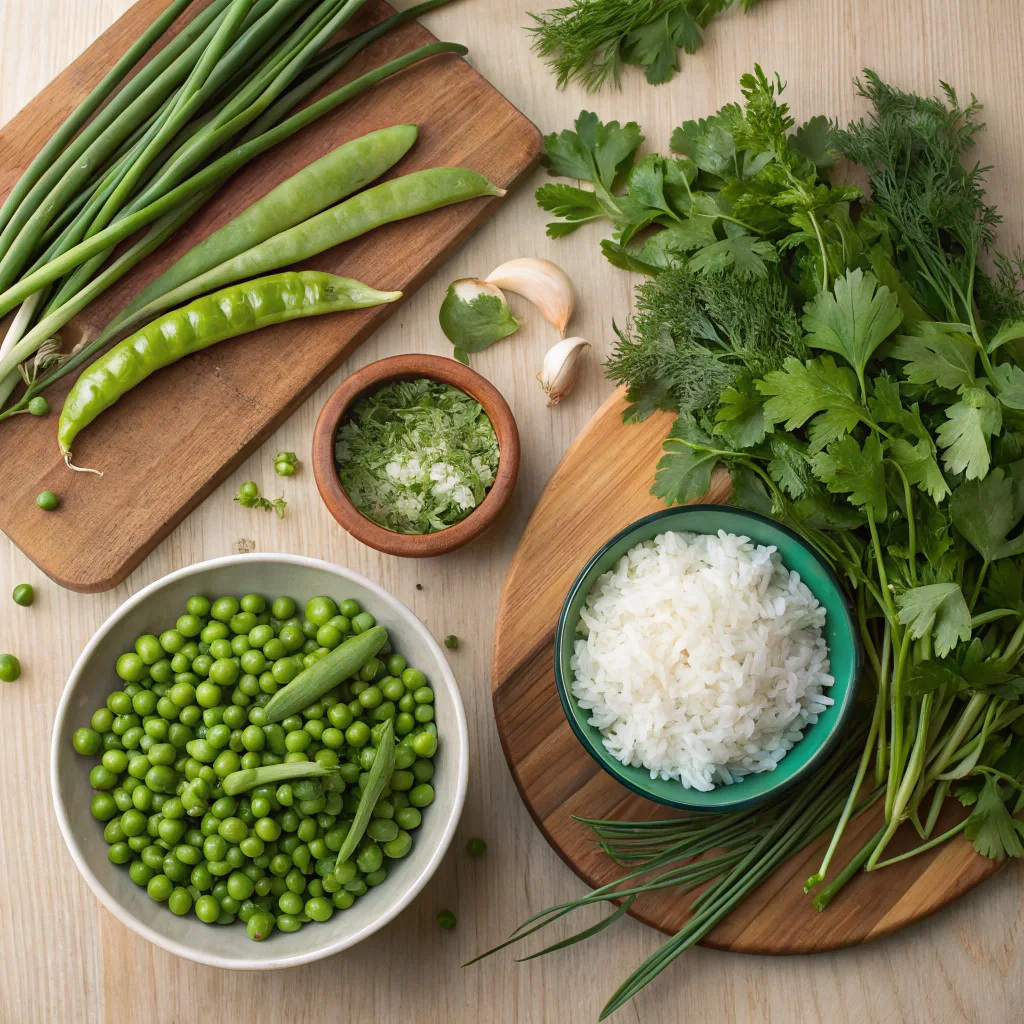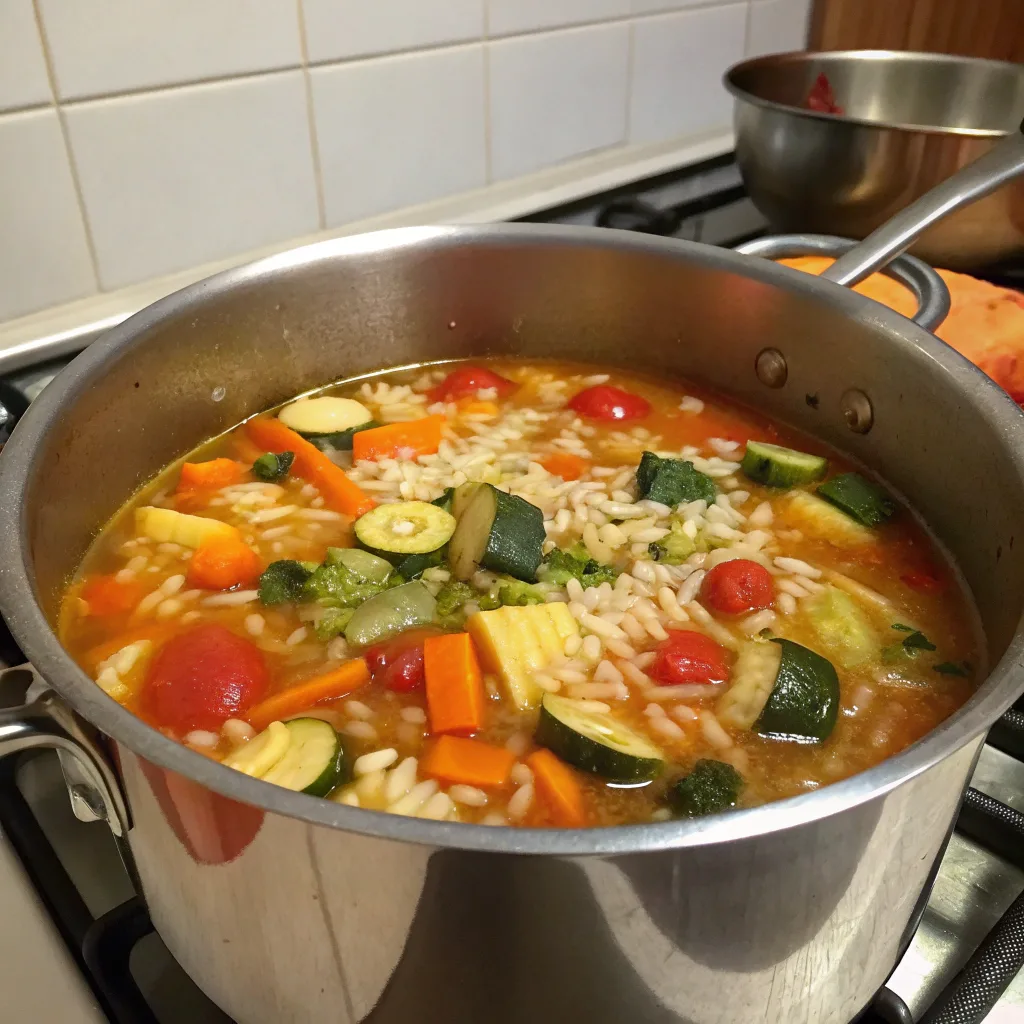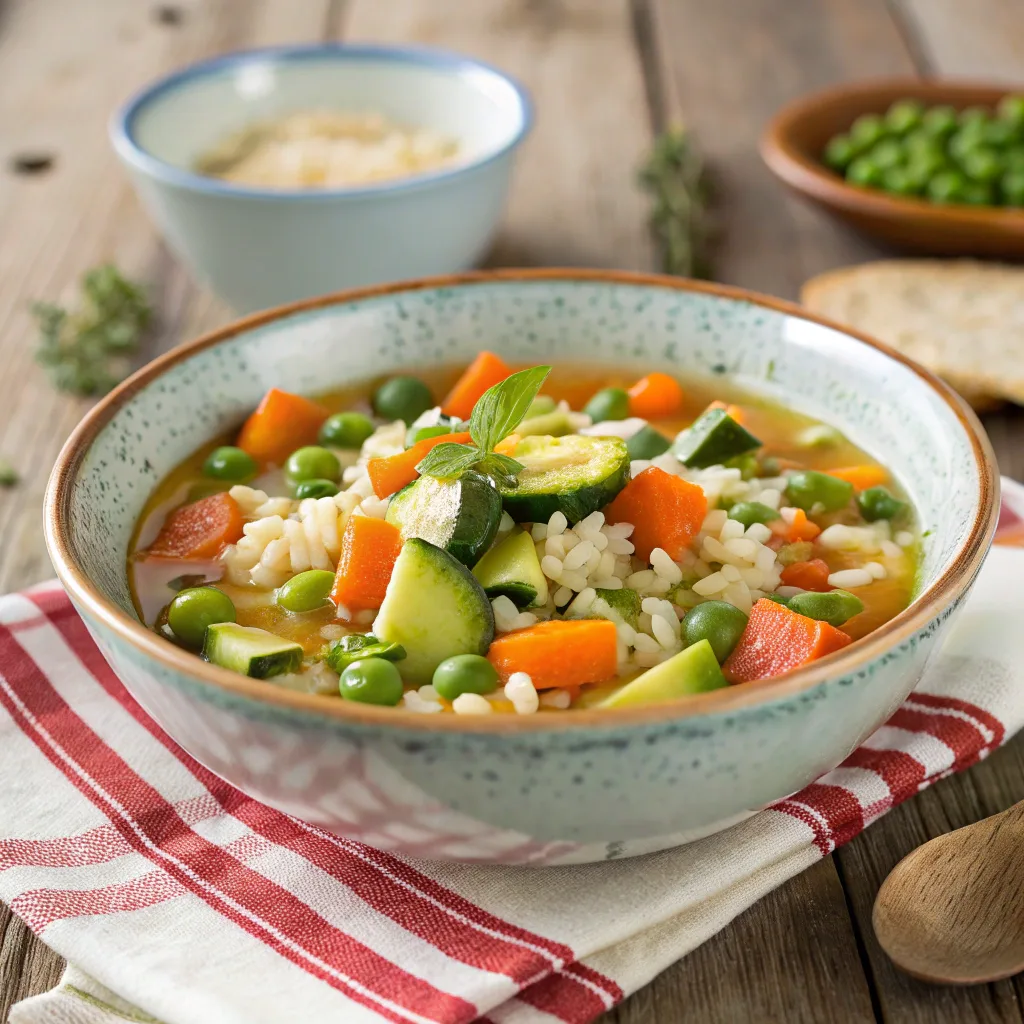Alright, picture this: It’s a breezy spring evening, and you’re craving something warm but not too heavy. You want comfort, but you also want freshness—something that screams spring in every spoonful. That’s where Spring Minestrone with Rice and Peas comes in.
This soup is the ultimate balance—light yet filling, packed with vibrant green veggies, and loaded with fresh herbs that make your kitchen smell like a dream. Unlike its heartier, winter-friendly cousin, traditional minestrone, this version skips the heavy tomato base and leans into delicate spring flavors instead. The rice makes it cozy, the peas add a little sweetness, and the broth ties everything together with a fresh, herby kick.
And let’s be real—springtime soups just hit differently. They’re perfect for those in-between days when the weather can’t make up its mind. One minute it’s sunny, the next it’s drizzling, and all you want is a warm bowl of goodness. (Sound familiar?)
But don’t worry, this isn’t one of those soups that takes all day to make. In fact, it’s pretty quick—meaning you can whip it up for a weeknight dinner or even meal prep it for the week. Plus, it’s easily customizable to fit your diet, whether you’re vegan, gluten-free, or looking to pack in some extra protein.
If you’re a soup lover, this recipe is a must-try. And if you’re really into soups, you might want to check out some other cozy bowl ideas like this Swamp Soup Recipe or the ever-popular Marry Me Chicken Soup. Trust me, you’ll want these in your rotation, too!
Why Spring Minestrone with Rice and Peas is the Perfect Spring Vegetable Soup
Spring has this magical way of making everything feel fresh and new, right? You swap out the heavy coats for light jackets, the dark dinners for brighter, crisper flavors—and honestly, your soup game should do the same. That’s exactly why Spring Minestrone with Rice and Peas hits just right this time of year.
The Beauty of Fresh, Seasonal Ingredients
Let’s talk ingredients for a sec. Spring is when produce is at its peak. We’re talking tender peas, crisp asparagus, fresh herbs, baby spinach, and carrots that actually taste like carrots. It’s like the farmers’ market threw a party in your pot. The veggies aren’t just fillers—they’re the stars.
You’ll notice that this minestrone skips the canned stuff and leans into seasonal, fresh vegetables. That’s what sets it apart from heavier soups like your classic Homemade Chicken Noodle Soup or wintertime stews. Think bright, snappy flavors instead of something that’ll weigh you down.
How It Differs from Traditional Minestrone
Traditional minestrone tends to be tomato-heavy, loaded with pasta, and sometimes feels like a full-on meal bomb. Delicious? Absolutely. But not exactly what you’re craving when the sun’s out and you’re in the mood for something lighter.
Spring minestrone ditches the tomato base and swaps in a clear, flavorful broth. Instead of pasta, we’re using rice, which keeps things a bit more delicate while still giving you that cozy, satisfying vibe. It’s perfect if you’re someone who finds classic minestrone a little too dense.
And you know how sometimes you have those leftover black beans or random legumes in your pantry? Yep, you can toss those in too. Just a heads-up though—if you’re using black beans, you might wanna check out tips like Should You Drain Black Beans for Soup? to avoid any bitter surprises (because no one wants bitter soup).
A Bowl of Comfort Without Feeling Heavy
What I love about this soup is how it satisfies without making you feel like you overdid it. The broth is light but layered with flavor, the rice gives it body, and the peas add that pop of sweetness. It’s the kind of meal you can enjoy with a side of crusty bread and not feel like you need to nap afterward.
Plus, it’s the perfect dish to customize based on whatever veggies you have lying around. Got leftover greens? Toss ‘em in. A can of beans sitting in your pantry? Throw those in too—just maybe check this guide on The Healthiest Beans for Soup if you’re aiming for a nutrition boost.
Ingredients for Spring Minestrone with Rice and Peas
Alright, let’s get down to business—what exactly goes into this bright, satisfying Spring Minestrone with Rice and Peas? Honestly, the beauty of this soup is how flexible and forgiving it is. You can swap, add, or tweak ingredients based on whatever you’ve got hanging out in your fridge or pantry. But here’s the base lineup that’ll have you nailing that fresh, spring flavor every single time.

Fresh Spring Vegetables for Minestrone with Rice and Peas
First things first—your veggies are the backbone of this minestrone. You want that vibrant, crisp vibe with every spoonful, so here’s what to grab:
- Carrots: Dice them up small so they cook evenly. They add sweetness and color.
- Celery: For that classic aromatic base. Don’t skip it.
- Asparagus: Spring’s shining star. Cut it into bite-sized pieces so it doesn’t get mushy.
- Zucchini: Brings a mild, fresh flavor and soaks up the broth beautifully.
- Peas: I like to use fresh when they’re in season, but honestly, frozen peas work just as well (more on that later).
- Spinach or Baby Kale: Toss in a handful at the end for extra greens without overcooking them.
Feel free to mix it up with green beans, leeks, or whatever else is catching your eye at the market. It’s super customizable.
Rice or Pasta: What’s Best for Spring Minestrone Soup?
Now here’s where spring minestrone flips the script. Instead of the usual pasta (which, hey, is amazing in classic versions like Homemade Chicken Noodle Soup), this recipe leans on rice.
Why rice?
It’s lighter, gives a cozy texture, and soaks up all that flavorful broth without turning the soup into a carb overload. I usually go for white rice or Arborio rice because they cook quicker and release a little starch, thickening the broth just enough without getting gloopy.
But if you’re looking to swap, brown rice or even wild rice can work—just keep in mind they’ll need a longer cooking time.
Best Broth for Spring Vegetable Minestrone with Rice
Don’t underestimate the broth—it’s what ties everything together.
- Vegetable broth: Perfect if you’re keeping it vegan or vegetarian.
- Chicken broth: Adds a richer, savory kick without being too heavy.
If you want to go all out, use homemade broth. But if you’re short on time (who isn’t?), store-bought works fine. Just go for low-sodium so you can control the seasoning.
Also, tossing in a Parmesan rind while the soup simmers? Game changer. It melts down and adds an incredible umami flavor. And if you’re vegan, no worries—you can skip it and amp up the flavor with extra garlic or nutritional yeast.
Oh, and speaking of seasoning—don’t forget fresh herbs. Parsley, basil, and a pinch of thyme take this soup from good to “oh wow” territory.
How to Make Spring Minestrone with Rice and Peas Step by Step
Alright, now that you’ve got your ingredients lined up, let’s get cooking! This Spring Minestrone with Rice and Peas is all about simple steps that come together for a bowl of magic. Trust me, once you make it, you’ll have this recipe on repeat.

Prepping Your Ingredients Like a Pro
Before you even touch the stove, take a few minutes to chop and prep everything. It’ll save you a ton of scrambling later.
- Dice the carrots, celery, and onion into small, even pieces. You want them to cook at the same rate.
- Chop the asparagus and zucchini into bite-sized chunks—nothing worse than fishing out giant pieces of veggie mid-bite.
- Rinse the rice to get rid of extra starch. It keeps the soup from turning overly thick.
- Mince some garlic, because let’s face it, garlic makes everything better.
- If you’re using fresh peas, shell them now. Frozen peas? Just measure them out and let them hang tight.
Quick pro tip: Keep your veggies grouped based on cooking time. Harder veggies (like carrots and celery) go in first, while the softer ones (zucchini, peas, spinach) join the party later.
Building Flavor in Spring Minestrone Soup with Aromatics
Now, heat a few tablespoons of olive oil in a big ol’ soup pot over medium heat. Toss in the onion, carrots, and celery. Sprinkle in a pinch of salt and cook until they start to soften—about 5 minutes.
Next, stir in the garlic and maybe a dash of red pepper flakes if you want a tiny kick. Let everything cook another minute until it smells amazing (because it will).
At this point, if you’ve got a Parmesan rind lying around, now’s the time to toss it in. It’ll melt into the broth and give the soup this extra savory depth. If not, no biggie—it’s still gonna be delicious.
How Long to Simmer Spring Minestrone with Rice and Peas
Once your aromatics are softened, pour in your broth of choice—veggie or chicken, both work. Bring it to a gentle boil.
Here’s where the magic happens:
- Add the rice and let it simmer for about 10-12 minutes, stirring occasionally so nothing sticks.
- After the rice has a good head start, toss in the zucchini and asparagus.
- Let everything cook for another 5-7 minutes until the veggies are tender but still bright.
Keep an eye on the broth level—if it’s looking too thick, add a splash more. Minestrone shouldn’t feel like a stew.
Adding Peas and Herbs to Finish Spring Minestrone
Last step—stir in the peas and fresh greens (spinach or kale). They only need about 2 minutes to soften up and turn that vibrant green.
Right before serving, add a squeeze of lemon juice and a handful of chopped parsley or basil. Trust me, that little pop of citrus brightens the whole thing.
Season to taste with salt, pepper, maybe even a touch of grated Parmesan on top if you’re feeling fancy. And boom—dinner’s done.
If you’re into soups that pack flavor without a lot of fuss, you might also wanna check out cozy bowls like Black Bean Soup or troubleshoot tips like Why Does My Black Bean Soup Taste Bitter?—perfect for upping your soup game across the board.
Pro Tips for Perfect Spring Minestrone with Rice and Peas
Alright, so you’ve got the basics down. But if you’re anything like me, you want your soup to go from “pretty good” to “holy smokes, this is next-level.” Here are my tried-and-true tips to elevate your Spring Minestrone with Rice and Peas—stuff I’ve learned after plenty of experimenting (and, let’s be honest, a few kitchen fails).
How to Get the Perfect Texture
Nobody wants mushy veggies or soggy rice, right? Here’s how to avoid both:
- Add rice early, veggies later: The rice needs a head start, but the tender greens and peas? Add those at the end. Overcooking peas is practically a crime.
- Keep the simmer gentle: A rolling boil might sound like a good idea, but it’ll break down your veggies too fast. Stick to a soft simmer and let the ingredients mingle without falling apart.
- Use short-grain rice: It releases just enough starch to give the broth a little body without turning it into glue. Long-grain rice doesn’t work as well here.
Secret Ingredients That Boost Flavor
Here’s where the magic really happens:
- Parmesan Rind: I’ve said it before, but it’s worth repeating. Toss a rind into the pot while the soup simmers and let it do its thing. It melts slowly and infuses the broth with a savory, umami-rich flavor.
- Lemon Juice or Zest: Right before serving, squeeze in some fresh lemon juice or grate a bit of zest. It brightens up the whole dish and balances the richness of the broth.
- Fresh Herbs at the End: Don’t just sprinkle them on top—stir a handful of chopped parsley, basil, or even dill into the pot. Adds that fresh, springy pop.
- A Touch of Olive Oil Drizzle: Right before serving, drizzle some good quality olive oil on top. It adds richness and ties the flavors together.
If you’re looking for more flavor tricks, check out other soup recipes like the ultra-savory Marry Me Chicken Soup—tons of layering techniques there you can borrow.
How to Store and Reheat Without Losing Freshness
Let’s face it—sometimes soup is even better the next day. But a few key steps will keep it from turning into a mushy mess:
- Store rice separately (if you can): If you’re planning ahead, cook the rice on the side and add it to individual bowls when serving. This stops it from soaking up all the broth overnight.
- Reheat gently: Don’t blast it in the microwave at full power. Low and slow on the stovetop keeps the veggies from getting overcooked.
- Add a splash of broth or water: Minestrone thickens as it sits, so loosen it up with a bit more liquid when reheating.
Also—if you end up with leftover beans from another recipe, like Black Bean Soup, toss ’em in here too. No waste, all flavor.
Spring Minestrone with Rice Variations for Any Diet
One of the things I love most about Spring Minestrone with Rice and Peas is how flexible it is. No matter your dietary needs—or even what random ingredients you’ve got in your fridge—you can tweak this recipe to fit your vibe. Here’s how you can switch it up without sacrificing flavor.
Vegan and Vegetarian Spring Minestrone Soup Options
Good news—this soup is already vegetarian! But to make it 100% vegan, you’ll just want to:
- Skip the Parmesan rind: Instead, toss in a tablespoon of nutritional yeast to give the broth that same savory depth.
- Use veggie broth: Stick with a high-quality vegetable broth to keep everything plant-based.
- Top with vegan Parmesan or more fresh herbs: A sprinkle of vegan cheese or fresh basil adds that extra flair without any dairy.
Honestly, the veggies and herbs do most of the heavy lifting flavor-wise, so you won’t feel like you’re missing out.
And while we’re on the plant-based train, if you’re all about hearty vegan soups, check out the Swamp Soup Recipe—another veggie-packed winner you’ll love.
Gluten-Free Version of Spring Minestrone with Rice
Luckily, this recipe is naturally gluten-free as long as you:
- Double-check your broth: Some store-bought broths sneak in gluten-containing additives. Look for a labeled gluten-free option.
- Use rice instead of pasta: Already done in this version, so you’re ahead of the game!
No need to make any fancy substitutions—it’s basically ready for gluten-free folks straight off the bat.
Protein-Packed Spring Minestrone: Chicken, Beans, or Tofu
If you want to turn this minestrone into more of a meal (you know, something that’ll actually hold you over ’til dinner), here are a few add-ins:
- Shredded rotisserie chicken: Just toss it in during the last 5 minutes of cooking. Easy, quick, and perfect for using up leftovers.
- White beans or chickpeas: Totally classic. They soak up the broth beautifully and add plant-based protein. Just a reminder—if you’re tossing in black beans instead, you might want to peek at Should You Drain Black Beans for Soup? for best results.
- Tofu cubes: For a vegan protein punch, sauté some firm tofu separately until golden, then toss it into your bowl before serving. Adds texture and extra protein without overpowering the soup’s light flavor.
Basically, this minestrone is a blank canvas. Whatever your dietary needs, it’s super easy to tweak without messing with the core spring vibe.
Pairing Ideas: What to Serve with Spring Minestrone
Okay, you’ve got this fresh, veggie-packed Spring Minestrone with Rice and Peas simmering away. But let’s be real—it’s even better when you’ve got the right sides to round out the meal. Whether you’re keeping it light or going full-on comfort food mode, here are some perfect pairings to serve alongside.
Best Bread Options for Dipping
Nothing—and I mean nothing—beats dunking some warm, crusty bread into a bowl of minestrone. A few options that’ll have you wiping the bowl clean:
- Garlic bread: Classic. Slather it in butter, garlic, maybe a little parsley—done.
- Sourdough slices: That tangy flavor pairs beautifully with the fresh veggies and herbs.
- Ciabatta rolls: Toast them up until golden and crispy on the outside but soft inside. Perfect for soaking up broth.
Pro tip: Drizzle the bread with olive oil and sprinkle a bit of sea salt before toasting. Instant upgrade.
Fresh Salads That Complement the Flavors
If you’re in the mood to keep things extra fresh, a salad on the side never hurts:
- Simple arugula salad: Tossed with lemon juice, olive oil, shaved Parmesan, and cracked pepper.
- Tomato cucumber salad: Bright, crisp, and keeps the meal light.
- Caprese-style plate: Fresh mozzarella, tomatoes, basil, drizzle of balsamic. Can’t go wrong.
The goal is something crunchy and refreshing to balance the cozy soup vibes.
Drink Pairings
If you’re looking to elevate dinner (or impress guests), the right drink makes all the difference:
- Sparkling water with lemon: Keeps it light, especially if you’re doing a weekday lunch.
- Herbal tea: Mint or chamomile tea can be surprisingly nice if you’re keeping things non-alcoholic and cozy.
And hey, if you’re all about building a full-on soup spread, why not add another bowl to the table? Something like this comforting Marry Me Chicken Soup makes a great “second course” option.
Final Thoughts: Why This Soup Will Be Your Springtime Go-To
Here’s the thing—once you’ve made Spring Minestrone with Rice and Peas, you’ll see why it deserves a spot in your regular rotation. It’s light but satisfying, packed with fresh veggies, and ridiculously customizable. You can make it vegan, load it up with protein, or even toss in random pantry staples and still end up with something delicious.
Plus, it’s the kind of recipe that feels fancy but doesn’t demand hours in the kitchen. Whether you’re meal-prepping for the week or whipping up something special for friends, this soup always delivers.
And if you’re a soup fanatic like me, don’t forget to explore other flavor-packed recipes like this hearty Black Bean Soup or troubleshoot your soup skills with tips like Why Does My Black Bean Soup Taste Bitter?.
FAQs: Answers to Your Spring Minestrone with Rice and Peas Questions
What is the secret ingredient in minestrone soup?
Honestly, it’s all about building layers of flavor. But if I had to name one secret weapon, it’s a Parmesan rind. Tossing it into the soup as it simmers gives the broth an unbeatable depth—rich, savory, and just the right amount of umami. And if you’re keeping it vegan, a spoonful of nutritional yeast does wonders, too.
Why do Jamaicans say rice and peas instead of rice and beans?
Fun fact: In Jamaica, “peas” actually refers to what many folks know as beans—specifically kidney beans or pigeon peas. So when Jamaicans say “rice and peas,” they’re really talking about rice cooked with beans and seasoned with coconut milk, thyme, and scallions. It’s a cultural twist in the lingo, and honestly, it tastes amazing.
What is spring minestrone soup?
Spring minestrone is the lighter, fresher cousin of the classic Italian minestrone. Instead of a heavy tomato base and pasta, it’s made with a clear broth, tender spring veggies (like peas, asparagus, and zucchini), and rice. Perfect for those warmer days when you still want something cozy but not overly filling.
What is the difference between minestrone and fagioli soup?
Both are Italian classics, but they’ve got their differences. Minestrone is a veggie-packed soup with a variety of vegetables, sometimes pasta or rice, and often beans. Pasta e fagioli (which literally means “pasta and beans”) focuses mainly on beans and small pasta, with fewer veggies. Minestrone is a bit more of a catch-all; fagioli is more bean-focused.
How to make minestrone soup taste better?
It’s all in the details! Start by sautéing aromatics like onions, garlic, and celery until soft. Add a Parmesan rind for richness, finish with a squeeze of lemon juice to brighten the flavor, and always use fresh herbs. And don’t forget a good-quality broth—it’s the backbone of the soup. For more flavor-boosting tricks, you might also want to check out our guide on fixing bitter soups.
What is Olive Garden minestrone soup made of?
Olive Garden’s minestrone is a hearty, veggie-based soup loaded with tomatoes, beans, pasta, carrots, celery, zucchini, and green beans, all simmered in a light tomato broth. It’s a vegetarian-friendly option, seasoned with Italian herbs like basil and oregano. Our spring minestrone takes a fresher, seasonal approach with rice and peas instead of pasta and beans.

